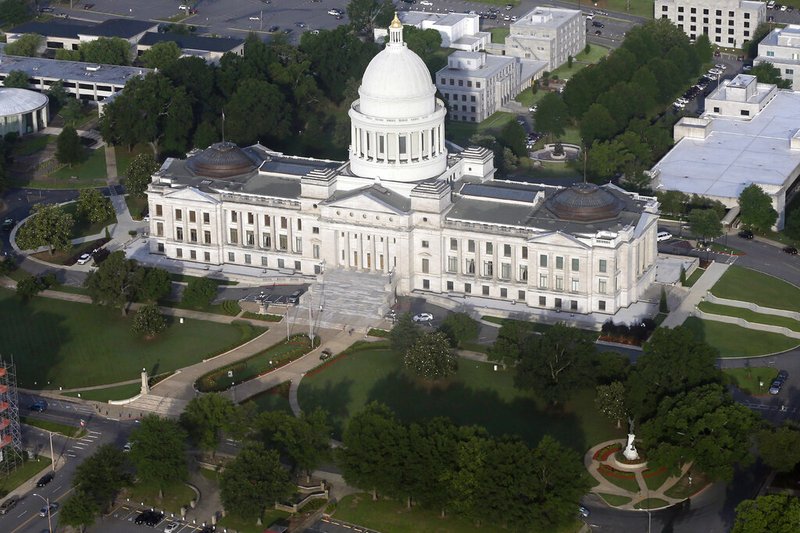Arkansas lawmakers are set to reconvene Monday to continue working on redrawing the state's four congressional districts, after inching toward a consensus amid numerous different proposals over three days last week.
The 93rd Arkansas General Assembly went back into session Wednesday, after taking an extended recess over the summer to wait for the U.S. Census Bureau data needed to reconfigure the lines for U.S. representatives.
Sen. Jason Rapert, R-Conway, who chairs the Senate Committee on State Agencies and Governmental Affairs, said Friday that lawmakers were still making progress though there were plenty of areas that were being worked out.
"People just have opinions in local areas and that's the way it always goes," he said.
Arkansas' population grew to 3,011,524 people over the past 10 years, making the ideal population for each district 752,881.
Much of lawmakers' discussion so far has focused on how to adjust the districts to compensate for substantial growth in the 3rd Congressional District, which covers Northwest Arkansas.
The 2nd Congressional District in Central Arkansas also grew, while the 1st Congressional District covering eastern Arkansas and the 4th Congressional District covering the state's western areas lost population in the last decade.
Negotiations have largely centered on the Northwest Arkansas region, with the issues of whether to continue splitting Sebastian County between the 3rd Congressional District and the 4th Congressional District and whether to add Madison County to the 3rd Congressional District while balancing for the region's growing population at the forefront.
There have also been different ideas emerging about where Pope County should go, with some maps putting it in the 2nd Congressional District and others putting it in the 4th Congressional District.
Several proposed redistricting maps that have garnered the most support among lawmakers would divide the state's largest and most populous county between two congressional districts. Pulaski County's population grew by 3% from 2010 to 2020, to 399,125.
The county is home to the state's capital city of Little Rock and one of a few counties that consistently votes for Democratic candidates in deep-red Arkansas. It is also more racially diverse than the state as a whole.
Rep. Dwight Tosh, R-Jonesboro, who chairs the House Committee on State Agencies and Governmental Affairs, said the panel would likely vote on House Bill 1971 by Rep. Nelda Speaks, R-Mountain Home, on Monday.
The bill emerged as the winner of a written-ballot vote the committee took last week to determine its top three maps, followed by House Bill 1970 by Rep. Jim Dotson, R-Bentonville.
HB1971 would split Pulaski County between the 2nd Congressional District and the 4th Congressional District while putting Sebastian County wholly in the 3rd District. It would put Pope County in the 4th District.
HB1970 would split Pulaski and Sebastian counties while adding Pope County to the 2nd District, something some lawmakers have pushed for. Sen. Breanne Davis, R-Russellville, is a co-sponsor with Dotson on several similar redistricting bills.
Dotson said splitting that county had been less contentious among lawmakers than other issues.
He said his initial version of the bill didn't divide Pulaski County.
"The original draft that I was working on didn't, but that was a lot of feedback from folks that wanted it split, and if you're going to split any counties that needed to be on that you started with," he said.
Though some lawmakers have argued that splitting Pulaski County makes sense to balance the population of the four districts, others have objected. Sen. Joyce Elliott, D-Little Rock, said it "cracks" a minority community.
Though Arkansas lawmakers redraw the congressional district maps every 10 years based on new census data, several things make this year different. Apportionment data was not delivered by the April 1 deadline because of delays caused by the covid-19 pandemic and abnormalities found in the numbers, according to the National Conference of State Legislatures.
Normally, the process of redrawing the districts takes place during the regular session without a recess. In 2011, reaching a compromise took four weeks. In 2001, the process took 17 days from when the legislation was first considered to when it was delivered to the governor.
The map lawmakers ultimately passed in 2011 split five counties: Crawford, Sebastian, Jefferson, Newton and Searcy. Like this year, that map was also drawn after census data showed rapid growth in Northwest Arkansas.
Officials in Crawford and Sebastian counties had asked lawmakers to keep them in the same district even before the 2010 census figures were released, the Arkansas Democrat-Gazette reported at the time.
This year marks the first time a Republican-controlled Arkansas Legislature will have drawn the maps since the Reconstruction era. The party first took control of the General Assembly in 2013.
While the Legislature is tasked with drawing the lines for U.S. representatives, the Arkansas Board of Apportionment will work on drawing the boundaries for state legislative districts. The board is made up of the governor, attorney general and secretary of state and is expected to begin meeting this month.
